- Recent Articles
- Most Citedi
- Most Visitedi
- Future Articles
-
Original Article06-27-2002
The Trial of Labor After one Cesarean Section
- Iracema de Mattos Paranhos Calderon,
- Jacqueline Leite Frade,
- Joelcio Francisco Abbade,
- Carolina Prado Diniz,
- Ivete Dalben, [ … ],
- Marilza Vieira Cunha Rudge
Views61

This is an Open Access article distributed under the terms of the Creative Commons Attribution License, which permits unrestricted use, distribution, and reproduction in any medium, provided the original work is properly cited. Abstract
Original ArticleThe Trial of Labor After one Cesarean Section
Revista Brasileira de Ginecologia e Obstetrícia. 2002;24(3):161-166
DOI 10.1590/S0100-72032002000300003
- Iracema de Mattos Paranhos Calderon,
- Jacqueline Leite Frade,
- Joelcio Francisco Abbade,
- Carolina Prado Diniz,
- Ivete Dalben,
- Marilza Vieira Cunha Rudge
Views61See morePurpose: to study trial of labor (TOL) for vaginal birth after one previous cesarean section. Methods: this is a retrospective cohort study that included 438 pregnant women with one previous cesarean section and their 450 newborns. They were divided into two groups – with and without TOL. The minimum sample size was 121 pregnant mothers per group. TOL was considered as an independent variable and vaginal birth and maternal and perinatal complication frequency as dependent variables. Both univariate and multivariate analyses were performed. The comparison of observed frequencies (%) was analyzed by the chi-squared test (chi²) with 5% significance, and linear regression from the odds ratio (OR) and confidence interval of 95% (CI95%). Results: TOL was used in 59.2% of vaginal deliveries. It was less used in women over 40 years (2.7% vs 6.7%) and in those with clinical or obstetrical diseases such as arterial hypertension (7.0%) and bleeding in the third trimester (0.3%). There was a higher risk for puerperal complications with cesarean deliveries (OR = 3.53, CI 95% = 1.57-7.93), independent of TOL. Perinatal mortality was dependent on neonatal weight and fetal malformations, not on TOL. Newborns from mothers not submitted to TOL were at a higher risk for developing breathing complications (OR = 1.92 CI 95% = 1.20-3.07). Conclusions: The results confirm that trial of labor after a previous cesarean section is a safe method – assisting vaginal delivery in 59.2% of births and not interfering with maternal and perinatal mortality. It is a treatment that should be stimulated.


This is an Open Access article distributed under the terms of the Creative Commons Attribution License, which permits unrestricted use, distribution, and reproduction in any medium, provided the original work is properly cited. -
DECLARAÇÃO DE BARCELONA
Revista Brasileira de Ginecologia e Obstetrícia. 2002;24(3):151-151
Views51PlumX Metrics
- Usage
- Full Text Views: 5180
- Abstract Views: 23
- Captures
- Readers: 14
- Social Media
- Shares, Likes & Comments: 1


This is an Open Access article distributed under the terms of the Creative Commons Attribution License, which permits unrestricted use, distribution, and reproduction in any medium, provided the original work is properly cited. Abstract
DECLARAÇÃO DE BARCELONA
Revista Brasileira de Ginecologia e Obstetrícia. 2002;24(3):151-151
DOI 10.1590/S0100-72032002000300001
PlumX Metrics
- Usage
- Full Text Views: 5180
- Abstract Views: 23
- Captures
- Readers: 14
- Social Media
- Shares, Likes & Comments: 1


This is an Open Access article distributed under the terms of the Creative Commons Attribution License, which permits unrestricted use, distribution, and reproduction in any medium, provided the original work is properly cited. -
A Grande Vitória
Revista Brasileira de Ginecologia e Obstetrícia. 2002;24(1):07-07
Views60

This is an Open Access article distributed under the terms of the Creative Commons Attribution License, which permits unrestricted use, distribution, and reproduction in any medium, provided the original work is properly cited. Abstract
A Grande Vitória
Revista Brasileira de Ginecologia e Obstetrícia. 2002;24(1):07-07


This is an Open Access article distributed under the terms of the Creative Commons Attribution License, which permits unrestricted use, distribution, and reproduction in any medium, provided the original work is properly cited. -
Original Article06-20-2002
Microinvasive Carcinoma in the Cone Specimen in Women With Colposcopically Directed Biopsy Suggesting CIN 3
- Priscila Garcia Figueiredo,
- Renata Clementino Gontijo,
- Sophie Françoise Mauricette Derchain,
- Fabiana Yumi Nakano,
- Julio César Teixeira, [ … ],
- Edson Zangiacomi Martinez
Views52PlumX Metrics
- Citations
- Citation Indexes: 1
- Usage
- Full Text Views: 64127
- Abstract Views: 2273
- Captures
- Readers: 3


This is an Open Access article distributed under the terms of the Creative Commons Attribution License, which permits unrestricted use, distribution, and reproduction in any medium, provided the original work is properly cited. Abstract
Original ArticleMicroinvasive Carcinoma in the Cone Specimen in Women With Colposcopically Directed Biopsy Suggesting CIN 3
Revista Brasileira de Ginecologia e Obstetrícia. 2002;24(1):37-43
DOI 10.1590/S0100-72032002000100006
- Priscila Garcia Figueiredo,
- Renata Clementino Gontijo,
- Sophie Françoise Mauricette Derchain,
- Fabiana Yumi Nakano,
- Julio César Teixeira,
- Edson Zangiacomi Martinez
Views52See morePurpose: to determine the factors associated with the detection of a microinvasive carcinoma in the cervical cone of women with a previous colposcopically directed biopsy compatible with cervical intraepithelial neoplasia (CIN) 3 and to evaluate the proportion of involved margins. Patients and methods: we reviewed the medical records of 385 women (mean age: 39 years) submitted to cold conization or conization by high frequency surgery (HFS) with a loop during the period from January 1993 to July 2000. These procedures were indicated on the basis of a biopsy compatible with (CIN) 3. Results: the diagnosis of the cone was compatible with (CIN) 3 in 243 (63%) women and with (CIN) 2 in 13 (3%). Only 10 presented HPV/CIN 1 (3%) and eight had no residual disease in the cone. However, 101 (26%) women presented a microinvasive carcinoma in the cone and 10 (3%) presented a frankly invasive carcinoma. Age, menstrual status and number of deliveries were not related to the severity of the cone lesion. Women with oncologic colpocytology changes suggestive of invasion presented a significantly higher risk of having a microinvasive or invasive carcinoma as determined by final histology (p<0.01), although 52 of the 243 women with CIN 2 or CIN 3 in the cone also showed a suggestion of invasion at colpocytology. Among the women with CIN 2 or 3, the epithelium was white in 44%, dotted in 21%, and mosaic-like in 17%. This proportion was similar for women with a microinvasive or invasive carcinoma, with these images being detected in 37%, 23% and 21% of the cases, respectively. Involvement of the cone margins was significantly higher among women submitted to HFS (49%) than among those submitted to cold conization (29%). Conclusion: the absence of independent clinical and colposcopic factors associated with the detection of a microinvasive carcinoma in women submitted to conization on the basis of a biopsy compatible with (CIN) 3 justifies the conical excision of the squamocolumnar junction in high grade cervical lesions.
PlumX Metrics
- Citations
- Citation Indexes: 1
- Usage
- Full Text Views: 64127
- Abstract Views: 2273
- Captures
- Readers: 3


This is an Open Access article distributed under the terms of the Creative Commons Attribution License, which permits unrestricted use, distribution, and reproduction in any medium, provided the original work is properly cited. -
Erratum06-19-2002Revista Brasileira de Ginecologia e Obstetrícia. 2002;24(1)
Views27

This is an Open Access article distributed under the terms of the Creative Commons Attribution License, which permits unrestricted use, distribution, and reproduction in any medium, provided the original work is properly cited. Abstract
ErratumRevista Brasileira de Ginecologia e Obstetrícia. 2002;24(1)
DOI 10.1590/S0100-72032002000100018
Views27Associação entre a incisura Diastólica das artérias uterinas e a histologia do leito placentário em grávidas com pré-eclâmpsia […]See more

This is an Open Access article distributed under the terms of the Creative Commons Attribution License, which permits unrestricted use, distribution, and reproduction in any medium, provided the original work is properly cited. -
Resumos de Teses06-19-2002
Contribuição ao Estudo do Laser de Vapor de Cobre no Tratamento da Endometriose Induzida Cirurgicamente em Coelhas
Revista Brasileira de Ginecologia e Obstetrícia. 2002;24(1):71-71
Views49

This is an Open Access article distributed under the terms of the Creative Commons Attribution License, which permits unrestricted use, distribution, and reproduction in any medium, provided the original work is properly cited. Abstract
Resumos de TesesContribuição ao Estudo do Laser de Vapor de Cobre no Tratamento da Endometriose Induzida Cirurgicamente em Coelhas
Revista Brasileira de Ginecologia e Obstetrícia. 2002;24(1):71-71
DOI 10.1590/S0100-72032002000100017
Views49Contribuição ao Estudo do Laser de Vapor de Cobre no Tratamento da Endometriose Induzida Cirurgicamente em Coelhas […]See more

This is an Open Access article distributed under the terms of the Creative Commons Attribution License, which permits unrestricted use, distribution, and reproduction in any medium, provided the original work is properly cited. -
Resumos de Teses06-19-2002
Avaliação do Potencial de Peroxidação Lipídica no Fluido Peritoneal de Mulheres Inférteis com Endometriose Pélvica
Revista Brasileira de Ginecologia e Obstetrícia. 2002;24(1):70-70
Views56

This is an Open Access article distributed under the terms of the Creative Commons Attribution License, which permits unrestricted use, distribution, and reproduction in any medium, provided the original work is properly cited. Abstract
Resumos de TesesAvaliação do Potencial de Peroxidação Lipídica no Fluido Peritoneal de Mulheres Inférteis com Endometriose Pélvica
Revista Brasileira de Ginecologia e Obstetrícia. 2002;24(1):70-70
DOI 10.1590/S0100-72032002000100016
Views56Avaliação do Potencial de Peroxidação Lipídica no Fluido Peritoneal de Mulheres Inférteis com Endometriose Pélvica […]See more

This is an Open Access article distributed under the terms of the Creative Commons Attribution License, which permits unrestricted use, distribution, and reproduction in any medium, provided the original work is properly cited. -
Resumos de Teses06-19-2002
Prevalência das Neoplasias Intra-epiteliais Cervicais e Lesões Induzidas pelo HPV nas Mulheres Soropositivas/AIDS
Revista Brasileira de Ginecologia e Obstetrícia. 2002;24(1):70-70
Views42

This is an Open Access article distributed under the terms of the Creative Commons Attribution License, which permits unrestricted use, distribution, and reproduction in any medium, provided the original work is properly cited. Abstract
Resumos de TesesPrevalência das Neoplasias Intra-epiteliais Cervicais e Lesões Induzidas pelo HPV nas Mulheres Soropositivas/AIDS
Revista Brasileira de Ginecologia e Obstetrícia. 2002;24(1):70-70
DOI 10.1590/S0100-72032002000100015
Views42Prevalência das Neoplasias Intra-epiteliais Cervicais e Lesões Induzidas pelo HPV nas Mulheres Soropositivas/AIDS […]See more

This is an Open Access article distributed under the terms of the Creative Commons Attribution License, which permits unrestricted use, distribution, and reproduction in any medium, provided the original work is properly cited.
-
Review Article03-18-2025
Efficacy of vitamin C supplementation during pregnancy in the prevention of preterm birth: a systematic review and meta-analysis
- Ana Gabriela Alves Pereira
 ,
, - Gabriela Oliveira Gonçalves Molino
 ,
, - Ana Clara Felix de Farias Santos
 ,
, - Maírla Marina Ferreira Dias
 ,
, - Nicole dos Santos Pimenta
 , [ … ],
, [ … ], - Pedro Henrique Costa Matos da Silva

Abstract
Review ArticleEfficacy of vitamin C supplementation during pregnancy in the prevention of preterm birth: a systematic review and meta-analysis
Revista Brasileira de Ginecologia e Obstetrícia. 2025;47:e-rbgo1
- Ana Gabriela Alves Pereira
 ,
, - Gabriela Oliveira Gonçalves Molino
 ,
, - Ana Clara Felix de Farias Santos
 ,
, - Maírla Marina Ferreira Dias
 ,
, - Nicole dos Santos Pimenta
 ,
, - Pedro Henrique Costa Matos da Silva

Views129Abstract
Objective:
Preterm birth is a leading global cause of neonatal mortality and morbidity, with oxidative stress playing a role in its pathogenesis. Vitamin C, a powerful antioxidant, may help reduce this risk. This study assessed the effectiveness of vitamin C supplementation, both alone and with vitamin E, in preventing preterm birth compared to a placebo.
Data source:
Databases were systematically searched in PubMed, Cochrane and Embase in December 2023 and updated in May 2024.
Study Selection:
Included RCTs evaluated vitamin C’s effect on preterm birth and related neonatal outcomes.
Data collect:
Statistical analyses used a random-effects model for pooled risk ratios (RR) and 95% confidence intervals (CI). Heterogeneity was assessed with the I² statistic.
Data synthesis:
Seventeen RCTs (21,567 patients) were analyzed. Vitamin C supplementation showed no significant difference compared to placebo for preterm birth (RR 1.04; 95% CI 0.96, 1.14). No significant differences were observed for neonatal death (RR 0.77; 95% CI 0.55, 1.08), NICU admission (RR 1.03; 95% CI 0.95, 1.13), preterm PROM (RR 1.04; 95% CI 0.63, 1.71), or birth weight (MD 52.41; 95% CI −19.65, 124.47). A slight decrease in gestational age was observed (MD 0.26; 95% CI −0.02, 0.55).
Conclusion:
Vitamin C supplementation alone or in combination with vitamin E does not significantly prevent preterm birth or improve related neonatal outcomes.
Key-words Ascorbic acidFetal membranes, premature ruptureGestational ageIntensive care units, neonatalPregnancyPremature birthVitamin C supplementationVitamin ESee more

This is an Open Access article distributed under the terms of the Creative Commons Attribution License, which permits unrestricted use, distribution, and reproduction in any medium, provided the original work is properly cited. 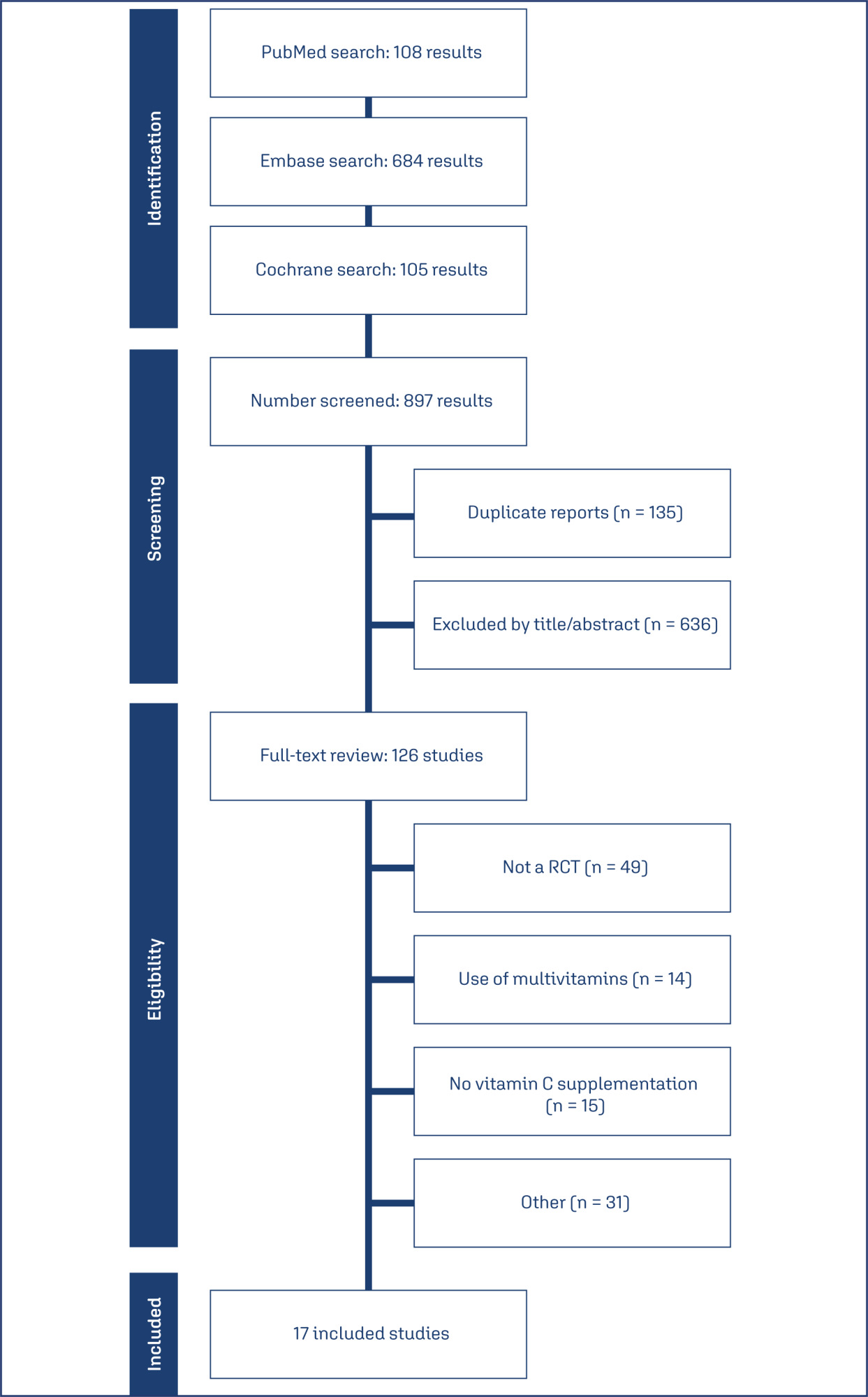
- Ana Gabriela Alves Pereira
-
FEBRASGO POSITION STATEMENT03-18-2025
Use of synthetic slings in the treatment of female stress urinary incontinence: Number 2 – 2025
- Marair Gracio Ferreira Sartori
 ,
, - Marilene Vale de Castro Monteiro
 ,
, - Cássia Raquel Teatin Juliato
 ,
, - Luiz Gustavo Oliveira Brito
 ,
, - Sergio Brasileiro Martins
 , [ … ],
, [ … ], - Emerson de Oliveira

Views178

This is an Open Access article distributed under the terms of the Creative Commons Attribution License, which permits unrestricted use, distribution, and reproduction in any medium, provided the original work is properly cited. Abstract
FEBRASGO POSITION STATEMENTUse of synthetic slings in the treatment of female stress urinary incontinence: Number 2 – 2025
Revista Brasileira de Ginecologia e Obstetrícia. 2025;47:e-FPS2
- Marair Gracio Ferreira Sartori
 ,
, - Marilene Vale de Castro Monteiro
 ,
, - Cássia Raquel Teatin Juliato
 ,
, - Luiz Gustavo Oliveira Brito
 ,
, - Sergio Brasileiro Martins
 ,
, - José Miguel de Deus
 ,
, - Ana Selma Bertelli Picoloto
 ,
, - Jorge Milhem Haddad
 ,
, - Andreisa Paiva Monteiro Bilhar
 ,
, - Leticia Maria de Oliveira
 ,
, - Rafael Mendes Moroni
 ,
, - Lucas Schreiner
 ,
, - Aljerry Dias do Rego
 ,
, - Daniela Siqueira Prado
 ,
, - Emerson de Oliveira



This is an Open Access article distributed under the terms of the Creative Commons Attribution License, which permits unrestricted use, distribution, and reproduction in any medium, provided the original work is properly cited. - Marair Gracio Ferreira Sartori
-
Original Article02-13-2025
Anemia levels in the preconception period and the first trimester of pregnancy: a national, multicentric and cross-sectional study
- Aytaj Jafarzade
 ,
, - Veli Mi̇hmanli
 ,
, - And Yavuz
 ,
, - Murat Akbaş
 ,
, - Gürcan Türkyilmaz
 , [ … ],
, [ … ], - Muhittin Tamer Mungan

Views283

This is an Open Access article distributed under the terms of the Creative Commons Attribution License, which permits unrestricted use, distribution, and reproduction in any medium, provided the original work is properly cited. Abstract
Original ArticleAnemia levels in the preconception period and the first trimester of pregnancy: a national, multicentric and cross-sectional study
Revista Brasileira de Ginecologia e Obstetrícia. 2025;47:-e-rbgo1001
DOI 10.61622/rbgo/2025rbgo10001
- Aytaj Jafarzade
 ,
, - Veli Mi̇hmanli
 ,
, - And Yavuz
 ,
, - Murat Akbaş
 ,
, - Gürcan Türkyilmaz
 ,
, - Esra Nur Özkan
 ,
, - Murat İbrahim Toplu
 ,
, - Yücel Kaya
 ,
, - Damla Yasemin Yenli̇k Kaya
 ,
, - Mustafa Yildiz
 ,
, - Ali Emre Ati̇k
 ,
, - Elif İlgazi̇ Kiliç
 ,
, - Burcu Özata
 ,
, - Sehtap Nazlı Kiliç Çeti̇n
 ,
, - Berk Bulut
 ,
, - Halide Gül Okuducu Aydin
 ,
, - Lale Aslanova
 ,
, - Çağdaş Nurettin Emekli̇oğlu
 ,
, - Melike Eren
 ,
, - Elif Uçar
 ,
, - Kaan Eray Uzun
 ,
, - Osman Ufuk Eki̇z
 ,
, - Muhittin Tamer Mungan

Views283Abstract
Objective
The study aimed to determine the level of anemia in pregnant women in the first trimester and in the preconception period by conducting nationwide research.
Methods
The study was designed as retrospective, cross-sectional, and multicenter research. A total of 17 centers from 13 provinces were included in the study. The study was conducted with the participation of two groups of patients who applied to the obstetrics polyclinic between 1 January 2023 and 1 July 2023, who were in the first trimester of pregnancy and who were in the preconception period planning pregnancy.
Results
In total 4,265 women were included in the study. Of these women, 3,884 (91%) were in the first trimester of their pregnancy and 381 (9%) were in the preconception period. Anemia was detected in 24.1% (n=1030) of the patients. Of these patients, 20.6% (n=877) were pregnant women in the first trimester and 3.6% (n=153) were in the preconception period. A statistically significant and positive relationship was found between anemia and meat consumption frequency, educational status, and socioeconomic status of the patients (p=0.000, p=0.000, p=0.000). In addition, a statistically significant and negative correlation was determined between anemia and the number of pregnancies and the parity number (p=0.001, p=0.000) in both groups.
Conclusion
Anemia is a public health problem. Anemia has been determined to be an important problem both in the preconception period and early periods of pregnancy. It is necessary to revise the programs and interventions to reduce the prevalence of anemia and redesign them in line with current conditions.
Key-words Anemia, iron-deficiencypreconception carePregnancy complications, hematologicPregnancy trimester, firstSee more

This is an Open Access article distributed under the terms of the Creative Commons Attribution License, which permits unrestricted use, distribution, and reproduction in any medium, provided the original work is properly cited. 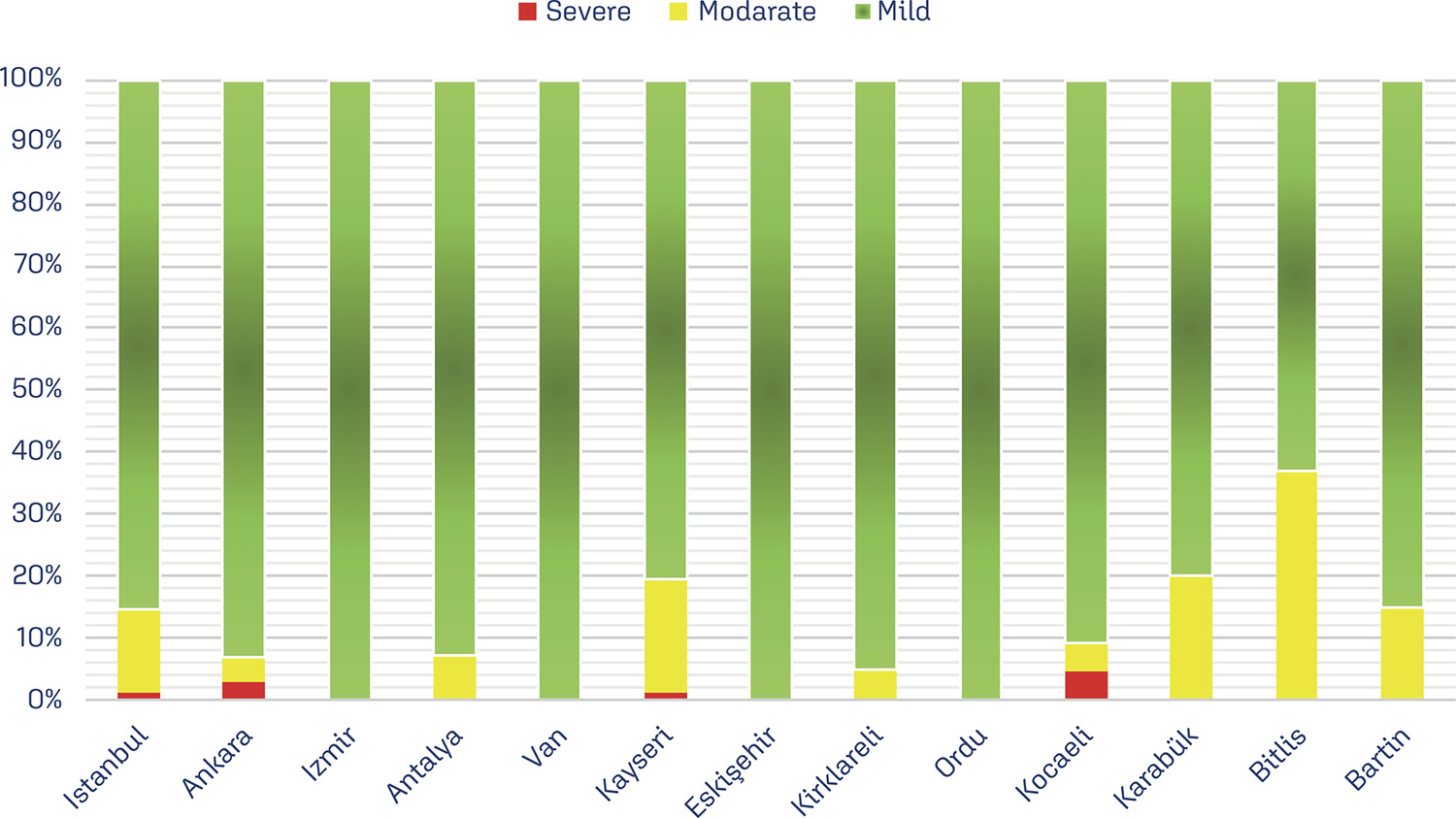
- Aytaj Jafarzade
-
FEBRASGO POSITION STATEMENT02-06-2025
Menopause in gynecologic cancer survivors: evidence for decision-making
- Agnaldo Lopes da Silva Filho
 ,
, - Mariana Seabra Leite Praça
 ,
, - Rívia Mara Lamaita
 ,
, - Eduardo Batista Cândido
 ,
, - Lucia Helena Simões da Costa Paiva
 , [ … ],
, [ … ], - Maria Celeste Osório Wender

Views252

This is an Open Access article distributed under the terms of the Creative Commons Attribution License, which permits unrestricted use, distribution, and reproduction in any medium, provided the original work is properly cited. Abstract
FEBRASGO POSITION STATEMENTMenopause in gynecologic cancer survivors: evidence for decision-making
Revista Brasileira de Ginecologia e Obstetrícia. 2025;47:e-FPS1
- Agnaldo Lopes da Silva Filho
 ,
, - Mariana Seabra Leite Praça
 ,
, - Rívia Mara Lamaita
 ,
, - Eduardo Batista Cândido
 ,
, - Lucia Helena Simões da Costa Paiva
 ,
, - José Maria Soares Júnior
 ,
, - Renato Moretti Marques
 ,
, - Maria Celeste Osório Wender

Views252See moreKey points
• Although advances in the treatment of gynecological cancer have improved survival rates, they may also increase the effects of induced menopause, especially in young women.
• Cancer treatments such as oophorectomy, gonadotoxic chemotherapy, and pelvic radiotherapy can induce menopause.
• Gonadotoxic chemotherapy, especially alkylating-containing regimens, often damages ovarian function and may result in permanent menopause.
• Pelvic radiotherapy usually results in permanent loss of ovarian function unless ovarian transposition is performed.
• Diagnosing menopause after cancer is challenging, and common diagnostic criteria such as 12 months or more of amenorrhea and elevated follicle-stimulating hormone (FSH) levels are not entirely reliable, since ovarian function may return years after treatment.
• A multidisciplinary approach to post-cancer menopause is essential and should include an appropriate line of care, since hormone replacement therapy after treatment of gynecologic malignancy is controversial.


This is an Open Access article distributed under the terms of the Creative Commons Attribution License, which permits unrestricted use, distribution, and reproduction in any medium, provided the original work is properly cited. 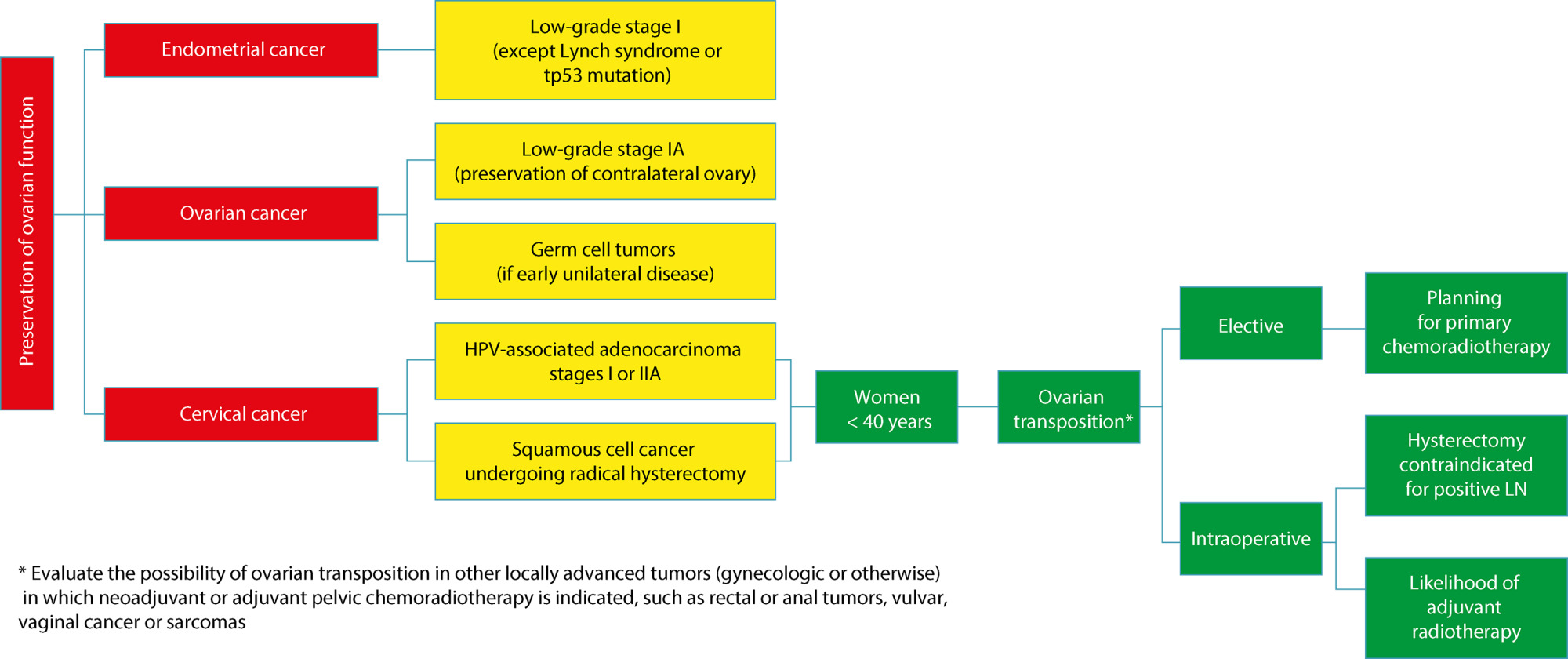
- Agnaldo Lopes da Silva Filho
-
Original Article01-23-2025
Therapeutic resources used by physiotherapists for the relief of labor pain: a cross-sectional study
- Alessandra de Campos Gonçalves
 ,
, - Giovana Garçoni Poli
 ,
, - Clara Maria de Araujo Silva
 ,
, - Ana Carolina Sartorato Beleza
 ,
, - Richard Eloin Liebano

Views261

This is an Open Access article distributed under the terms of the Creative Commons Attribution License, which permits unrestricted use, distribution, and reproduction in any medium, provided the original work is properly cited. Abstract
Original ArticleTherapeutic resources used by physiotherapists for the relief of labor pain: a cross-sectional study
Revista Brasileira de Ginecologia e Obstetrícia. 2025;47:e-rbgo99
- Alessandra de Campos Gonçalves
 ,
, - Giovana Garçoni Poli
 ,
, - Clara Maria de Araujo Silva
 ,
, - Ana Carolina Sartorato Beleza
 ,
, - Richard Eloin Liebano

Views261Abstract
Objective
The aim of the study was to identify non-pharmacological therapeutic resources used by physiotherapists for pain relief during labor and childbirth.
Methods
This is a cross-sectional study conducted from January to March 2021, followed the STROBE guidelines. It included Brazilian physiotherapists with a minimum of two years in obstetric care experience. Data were collected using a 33-item online questionnaire, which covered sociodemographic details and the utilization of non-pharmacological resources. Descriptive analysis was used to determine participant characteristics. Associations between sociodemographic variables, specialist titles, participation in scientific events, and methods for pain relief methods during childbirth were assessed using chi-square or Fisher’s exact tests. Data were analyzed using SPSS version 23.0, with a significance level set at 5% (p < 0.05).
Results
A total of 114 Brazilian physiotherapists participated in this study. Participants chose to utilize non-pharmacological therapies and resources that are within the scope of physiotherapists’ practice for labor pain. Kinesiotherapy with the use of devices was the most employed technique for pain relief during the birthing process.
Conclusion
The study highlights the prevalent use of non-pharmacological therapeutic resources, particularly kinesiotherapy with devices, among Brazilian physiotherapists for labor pain relief.
Key-words childbirthlabor painLabor, obstetricNon-pharmacological resourcespain managementParturiationPhysical therapistsPregnancysurveys and questionnairesSee more

This is an Open Access article distributed under the terms of the Creative Commons Attribution License, which permits unrestricted use, distribution, and reproduction in any medium, provided the original work is properly cited. - Alessandra de Campos Gonçalves
-
Original Article01-23-2025
Maternal erythrocytosis as a risk factor for small for gestational age at term in high altitude
- Wilfredo Villamonte-Calanche
 ,
, - Marco Antonio Salazar-Zegarra
 ,
, - Cleto De-la-Torre-Dueñas
 ,
, - Alexandra Villamonte-Jerí
 ,
, - Adaí Vera-Luza
 , [ … ],
, [ … ], - Nuria Huanca-Huirse

Abstract
Original ArticleMaternal erythrocytosis as a risk factor for small for gestational age at term in high altitude
Revista Brasileira de Ginecologia e Obstetrícia. 2025;47:e-rbgo98
- Wilfredo Villamonte-Calanche
 ,
, - Marco Antonio Salazar-Zegarra
 ,
, - Cleto De-la-Torre-Dueñas
 ,
, - Alexandra Villamonte-Jerí
 ,
, - Adaí Vera-Luza
 ,
, - Milagros Hilari Bustinza-Apaza
 ,
, - Nuria Huanca-Huirse

Views257Abstract
Objective
To determine if maternal erythrocytosis is a risk factor for small-for-gestational age at term at 3,400-m altitude in pregnant women without intercurrent disease.
Methods
Analytical study of retrospective cohorts at Cusco, a city at 3,400-m altitude. Our participants were 224 and 483 pregnant women with and without exposure to maternal erythrocytosis, respectively. A logistic regression with the goodness of fit to the proposed model was also performed with the Hosmer and Lemeshow test, evaluating the small-for-gestational-age results with or without exposure to hemoglobin >14.5 g/dl.
Results
The incidence of small-for-gestational-age was 6.9% for this entire cohort. The maternal erythrocytosis during gestation without any maternal morbidity at 3,400-m altitude has an ORa=0.691 (p=0.271) for small-for-gestational-age at term. Inadequate prenatal control has an ORa=2.115 (p=0.016) for small-for-gestational-age compared to adequate prenatal control.
Conclusion
Maternal erythrocytosis in pregnant women without any morbidity is not a risk factor for small-for-gestational-age at 3,400 m-altitude.
Key-words AltitudeFetal growth retardationGestational agehemoglobinHypoxiaMorbidityNeonatal mortalityPolycythemiaPregnancyPregnant womenRisk factorssmall for gestational ageSee more

This is an Open Access article distributed under the terms of the Creative Commons Attribution License, which permits unrestricted use, distribution, and reproduction in any medium, provided the original work is properly cited. - Wilfredo Villamonte-Calanche
-
Original Article01-23-2025
Comparison of serum ischemia modified albumin levels between preeclamptic and healthy pregnant women
- Dinç Zuhal
 ,
, - Çakar Erbil
 ,
, - Kumru Pınar
 ,
, - Erel Özcan
 ,
, - Neşelioğlu Salim
 , [ … ],
, [ … ], - Boz Gizem

Abstract
Original ArticleComparison of serum ischemia modified albumin levels between preeclamptic and healthy pregnant women
Revista Brasileira de Ginecologia e Obstetrícia. 2025;47:e-rbgo97
Views310See moreAbstract
Objective
Our aims to compare level of serum ischemia modified albümin(IMA) between healthy and preeclamptic pregnancies and to evaluate the relationship of IMA with preeclampsia, preeclampsia severity and perinatal outcomes.
Methods
Our study is a prospective case-control study. A total of 134 pregnant women (66 preeclamptic and 68 healthy pregnant) between 18-45 years of age and between 24- 41 gestational weeks participated. Serum IMA levels were measured by the Albumin Cobalt Binding (ACB) test.
Results
The mean IMA values were found to be significantly higher in the preeclampsia group compared to the control group (p<0,001). Patients were divided into 3 groups; severe preeclampsia(n=29), non-severe preeclampsia(n=37) and healthy pregnant(n=68). Statistically significant difference was not found between severe preeclampsia and non-severe preeclampsia (p=0.505). The performance of IMA values in predicting the development of preeclampsia among all participants was evaluated with Receiver Operating Characteristic (ROC) analysis. According to the ROC analysis, the best cut-off value at which the maximum area under the curve (AUC) was obtained was found when IMA>0.98(AUC: 0.690 95% Confidence Interval (CI): 0.600-0.781 p<0.001). When IMA threshold value of >0.98 was taken to predict preeclampsia; the sensitivity, specificity, positive predictive value (PPV) and negative predictive value (NPV) were calculated as 65.15%, 64.71%, 64.18%, and 65.67%, respectively.
Conclusion
IMA level may be a useful new marker in recognizing and predicting preeclampsia. However, despite the power of recognizing the disease, serum IMA levels do not give an idea about the severity of the disease. More comprehensive studies are needed in order to use IMA levels in the diagnosis of preeclampsia.


This is an Open Access article distributed under the terms of the Creative Commons Attribution License, which permits unrestricted use, distribution, and reproduction in any medium, provided the original work is properly cited. - Dinç Zuhal
-
Original Article01-23-2025
A comparison of the efficacy of the effect of online versus face-to-face group counseling based on positive-approach on sexual intimacy of women after benign abdominal hysterectomy: a clinical trial
Revista Brasileira de Ginecologia e Obstetrícia. 2025;47:e-rbgo102
Views252

This is an Open Access article distributed under the terms of the Creative Commons Attribution License, which permits unrestricted use, distribution, and reproduction in any medium, provided the original work is properly cited. Abstract
Original ArticleA comparison of the efficacy of the effect of online versus face-to-face group counseling based on positive-approach on sexual intimacy of women after benign abdominal hysterectomy: a clinical trial
Revista Brasileira de Ginecologia e Obstetrícia. 2025;47:e-rbgo102
Views252See moreAbstract
Objective
The study investigates the influence of positive-approach counseling through both online and face-to-face group therapy on the sexual intimacy of women after benign complete abdominal hysterectomy, addressing challenges such as the loss of femininity and other psychosexual complications that disrupt the couple’s relationship post-surgery.
Methods
This is a parallel clinical trial, conducted in 2023 in Yazd, Iran; with sixty-six participants post- benign complete abdominal hysterectomy were randomly assigned to online and face-to-face counseling groups. Each group had eight 90-minute sessions, and data were collected using demographic and intimacy scale (IS) questionnaires at baseline, eighth week, and twelfth week follow-up. Statistical analysis used SPSS version 23 (P < 0.05).
Results
In the Online Group, the mean sexual intimacy score significantly increased from 72.42 ± 9.05 to 87.06 ± 7.98 at eight weeks and 90.30 ± 8.23 at twelve weeks (P < 0.001). In the Face-to-Face Group, the mean score increased from 70.21 ± 6.75 to 81.24 ± 5.55 at eight weeks and 85.03 ± 5.40 at twelve weeks (P < 0.001). Online counseling proved more effective than face-to-face counseling in enhancing sexual intimacy (P = 0.043).
Conclusion
Online and face-to-face counseling based on the positive approach improved sexual intimacy in women with a history of benign hysterectomy. Moreover, it seems that online counseling was more effective, so it is recommended that this method be employed in follow-up sessions after hysterectomy. Iranian Registry of Clinical Trials – IRCT20230209057373N1


This is an Open Access article distributed under the terms of the Creative Commons Attribution License, which permits unrestricted use, distribution, and reproduction in any medium, provided the original work is properly cited. 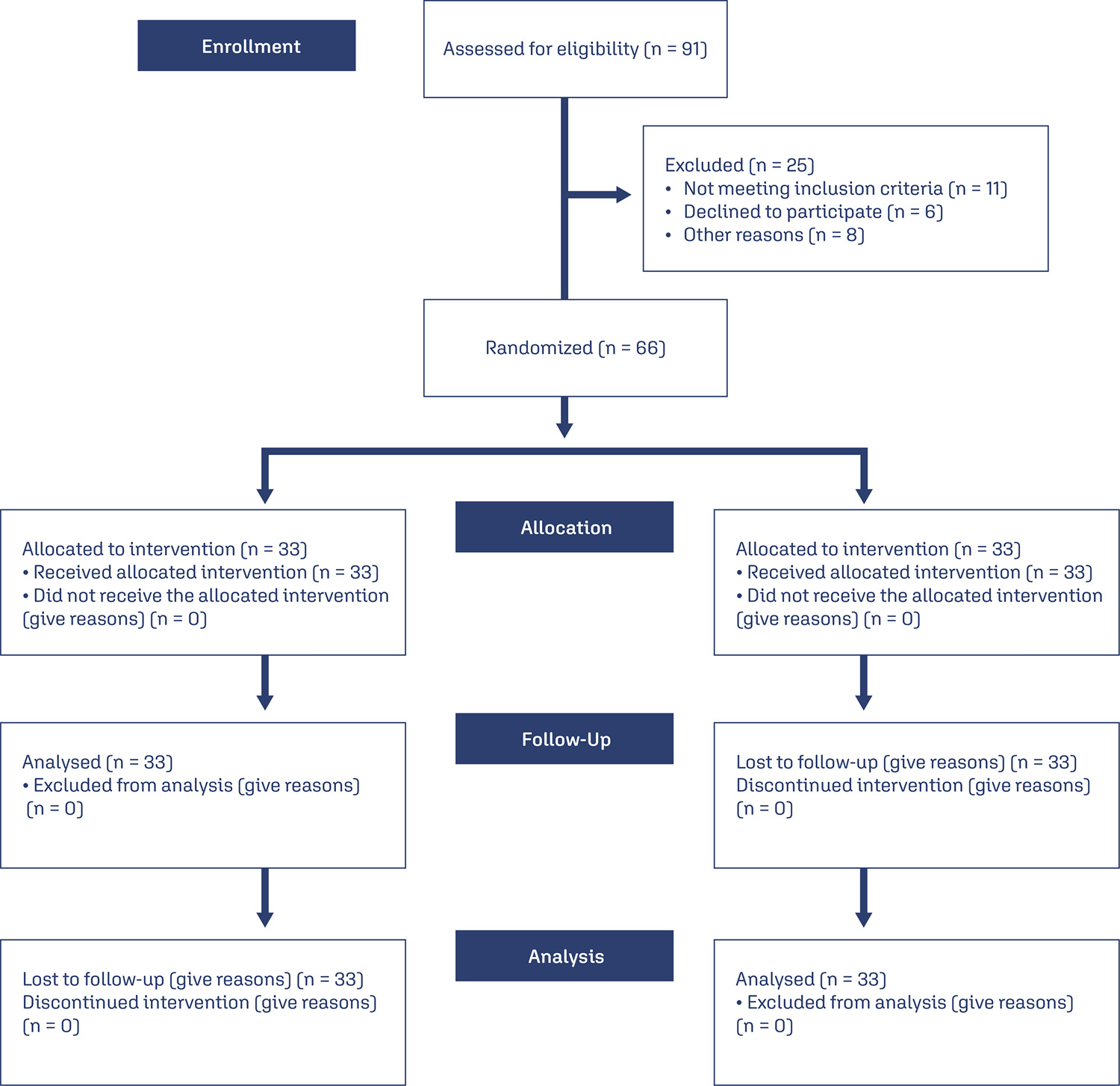
-
Review Article03-18-2025
Short cervix and use of cervical pessary for preventing preterm birth in singleton and twin pregnancies: a systematic review and meta-analysis
- Ana Clara Felix de Farias Santos
 ,
, - Nicole dos Santos Pimenta
 ,
, - Ana Gabriela Alves Pereira
 ,
, - Gabriela Oliveira Gonçalves Molino
 ,
, - Maírla Marina Ferreira Dias
 , [ … ],
, [ … ], - Pedro Henrique Costa Matos da Silva

Abstract
Review ArticleShort cervix and use of cervical pessary for preventing preterm birth in singleton and twin pregnancies: a systematic review and meta-analysis
Revista Brasileira de Ginecologia e Obstetrícia. 2025;47:e-rbgo10
- Ana Clara Felix de Farias Santos
 ,
, - Nicole dos Santos Pimenta
 ,
, - Ana Gabriela Alves Pereira
 ,
, - Gabriela Oliveira Gonçalves Molino
 ,
, - Maírla Marina Ferreira Dias
 ,
, - Pedro Henrique Costa Matos da Silva

Views172See moreAbstract
Objective:
Preterm birth remains a significant contributor to neonatal morbidity and mortality. The use of cervical pessaries as an intervention for preventing preterm delivery in women with a short cervix has been a subject of interest. We evaluated the effectiveness of cervical pessary compared to standard care in preventing preterm delivery in women with a short cervix.
Data source:
Databases were systematically searched in PubMed, Cochrane, and Embase databases in December 2023.
Study selection:
Randomized clinical trials with the outcomes of interest were included.
Data collect:
We computed risk ratios for binary endpoints, with 95% confidence intervals. Heterogeneity was assessed using I2 statistics. Data were analyzed using R software (version 4.3.0). The primary outcomes of interest were preterm delivery before 37 weeks, and preterm delivery before 34 weeks.
Data synthesis:
Seventeen studies with 5,704 patients were included. The use of cervical pessary was associated with a decreased risk of preterm delivery before 37 (RR 0.88; 95% CI 0.81-0.96) and 34 weeks (RR 0.79; 95% CI 0.63-0.99) of gestation in twin pregnancies as compared to standard care without progesterone. There were no significant differences in preterm delivery in singleton pregnancy, neonatal outcomes, preterm premature rupture of the membranes or chorioamnionitis.
Conclusion:
The use of cervical pessary was associated with a significant reduction in preterm delivery at 34 and 37 weeks of gestation in twin pregnancies among patients with a short cervix compared to no treatment. No significant difference was found in singleton pregnancies or maternal outcomes.


This is an Open Access article distributed under the terms of the Creative Commons Attribution License, which permits unrestricted use, distribution, and reproduction in any medium, provided the original work is properly cited. 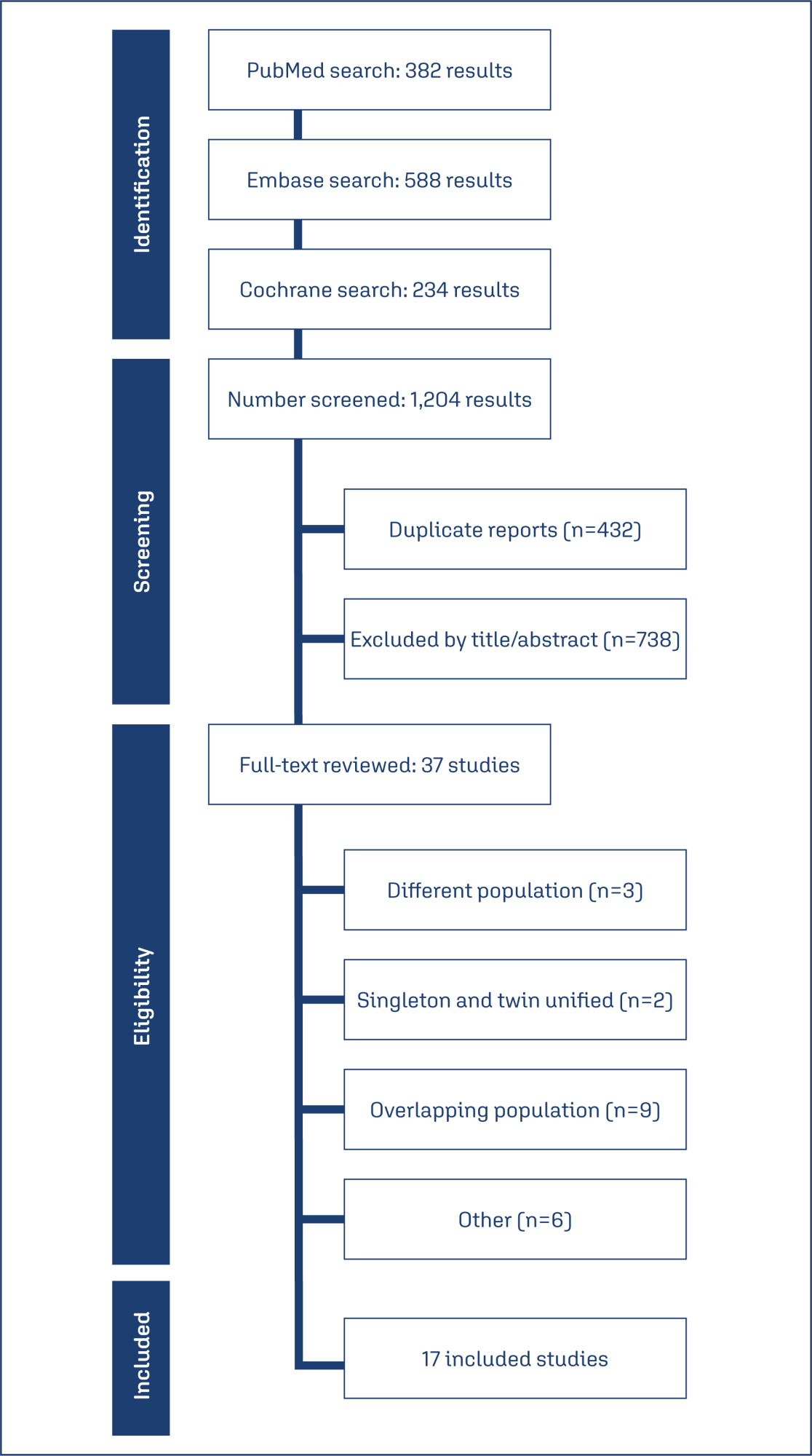
- Ana Clara Felix de Farias Santos
-
Short Communication03-18-2025
Contraception in adolescents with mental disorders: adherence and satisfaction in the use of depot medroxyprogesterone acetate
Revista Brasileira de Ginecologia e Obstetrícia. 2025;47:e-rbgo9
Views172

This is an Open Access article distributed under the terms of the Creative Commons Attribution License, which permits unrestricted use, distribution, and reproduction in any medium, provided the original work is properly cited. Abstract
Short CommunicationContraception in adolescents with mental disorders: adherence and satisfaction in the use of depot medroxyprogesterone acetate
Revista Brasileira de Ginecologia e Obstetrícia. 2025;47:e-rbgo9
Views172See moreAbstract
Objective:
To evaluate the continuation rate, satisfaction, and reasons for discontinuation of depot medroxyprogesterone acetate (DMPA) in adolescents treated in a mental health service.
Methods:
Prospective cohort study conducted in a reference unit for the care of adolescents with mental disorders (MDs) and intellectual disabilities (IDs). All patients received a gynecological consultation and an educational group on contraceptive methods. Sociodemographic data on age, education and gynecological data (menarche, coitarche, regularity of menstrual cycles and presence of symptoms) were collected. Follow-up was quarterly for 12 months, during which symptoms, desire to continue, and satisfaction with the use of the quarterly injectable were assessed.
Results:
Eight hundred and sixty-two sexually active adolescents were supported, 532 adolescents chose to use the quarterly injectable, and 69 of these agreed to participate in the study. The mean age of users was 15.5 years (SD=0.91). After 12 months of follow-up, 34 (49.3%) of the 69 adolescents continued to use the method and 36 (52.3%) were satisfied. Among the 33 (47.8%) who discontinued use, the most common reasons were irregular bleeding and weight gain.
Conclusions:
Adolescents with intellectual disabilities and/or other mental disorders showed a significant rate of continuation and satisfaction with the use of the depot medroxyprogesterone acetate at 12 months, and the most common reasons for discontinuation were irregular uterine bleeding and weight gain.


This is an Open Access article distributed under the terms of the Creative Commons Attribution License, which permits unrestricted use, distribution, and reproduction in any medium, provided the original work is properly cited. 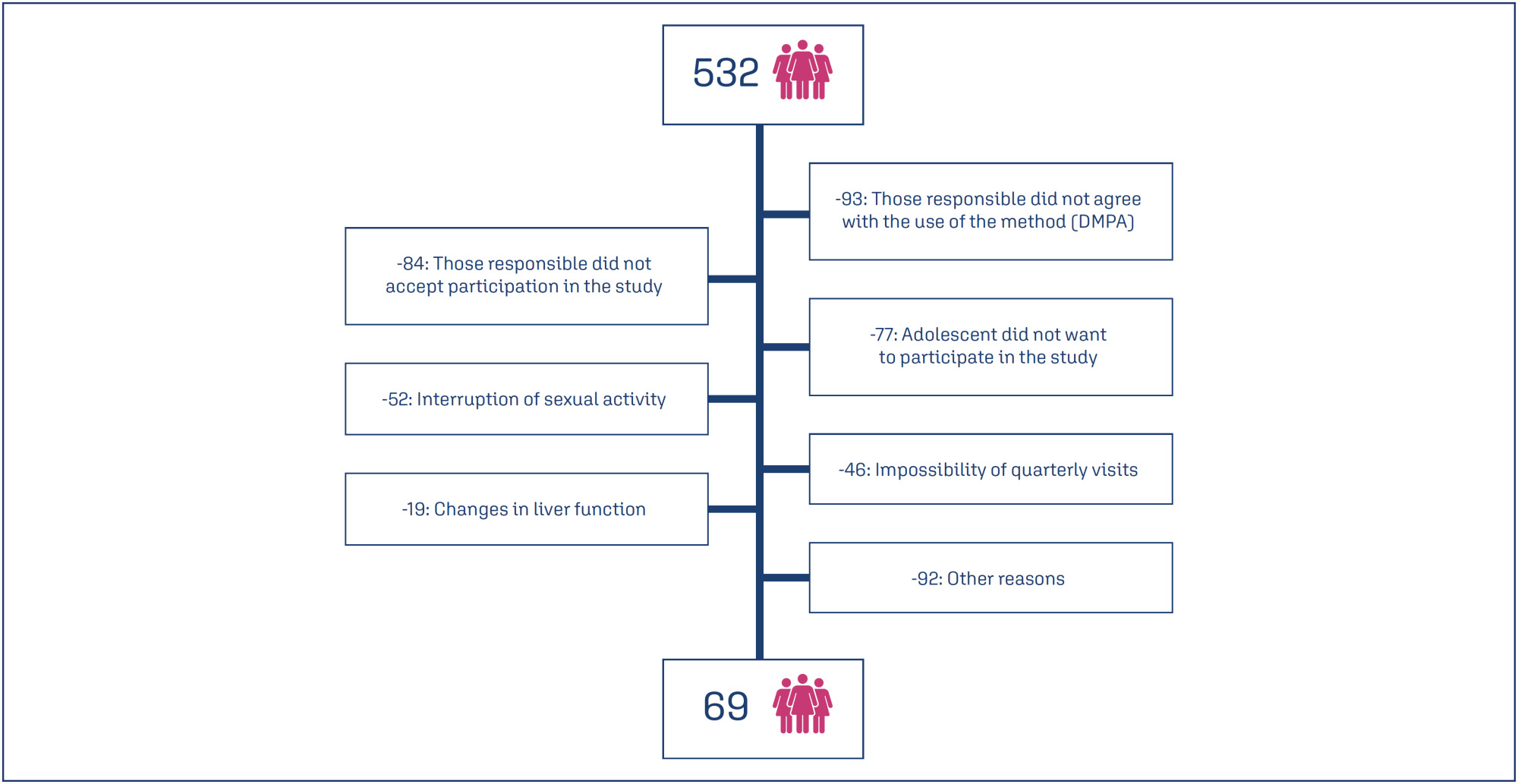
-
Original Article03-18-2025
The experience of pregnancy in the COVID-19 pandemic
- Mariana Corniani Lopes
 ,
, - Cheryl Tatano Beck
 ,
, - Zelina Hilária de Souza Rosa
 ,
, - Erika de Sá Vieira Abuchaim

Views187

This is an Open Access article distributed under the terms of the Creative Commons Attribution License, which permits unrestricted use, distribution, and reproduction in any medium, provided the original work is properly cited. Abstract
Original ArticleThe experience of pregnancy in the COVID-19 pandemic
Revista Brasileira de Ginecologia e Obstetrícia. 2025;47:e-rbgo8
- Mariana Corniani Lopes
 ,
, - Cheryl Tatano Beck
 ,
, - Zelina Hilária de Souza Rosa
 ,
, - Erika de Sá Vieira Abuchaim

Views187See moreAbstract
Objective:
To describe women’s experience of pregnancy during the COVID-19 pandemic.
Methods:
A qualitative study conducted in a private maternity hospital, from May, 2020 to November, 2021, with women aged ≥ 18 years, gestational age ≥ 36 weeks at birth and ≥ 24 hours post-partum. Data collected through semi-structured interviews, recorded, transcribed, and analyzed adopting Krippendorff’s Content Analysis as theoretical-methodological framework.
Results:
Four main themes emerged: Fear, Taking care and celebrating pregnancy: adjusting to the new reality, Harms of Isolation, and Benefits of Isolation. The fear of contamination and its impact on the health of mother and child resulted in the adoption of severe social isolation, including from those considered sources of support by the expecting mother. Overwhelmed, some of the participants reported loneliness and psychic suffering. The opportunity to focus on the pregnancy, the preparations for the arrival of the child, and the family made isolation a beneficial and positive period for other women.
Conclusion:
The experience of pregnancy in the Pandemic was an event outside of the ordinary and common. The expecting mother faced her worst fears on a daily basis and attended prenatal care, in order to ensure her child would be born healthy. The celebration of the baby’s life, amid so many deaths, had to be adjusted to the virtual environment. It was a tense, solitary, and ambiguous period, which demanded a lot from the mental health of some participants, but to others, brought advantages that would not have been possible in different times.


This is an Open Access article distributed under the terms of the Creative Commons Attribution License, which permits unrestricted use, distribution, and reproduction in any medium, provided the original work is properly cited. 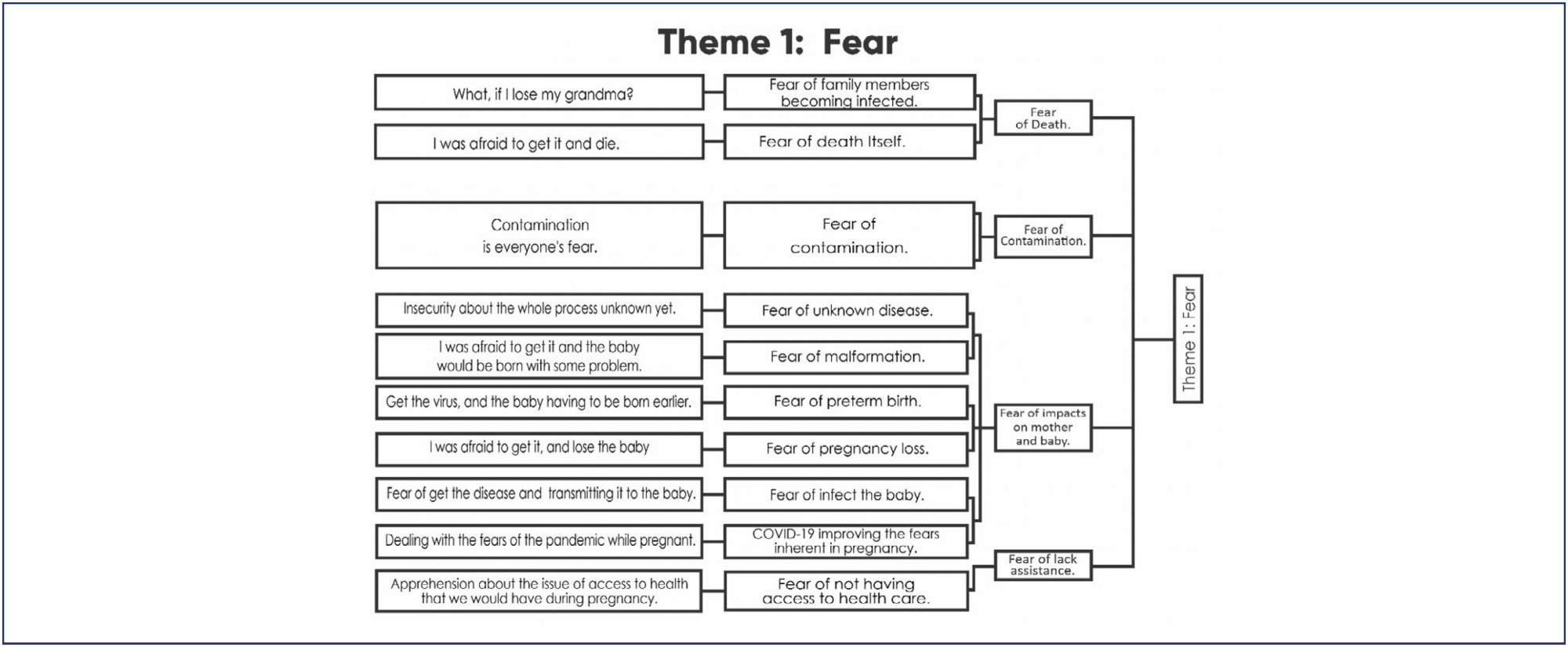
- Mariana Corniani Lopes
-
Original Article03-18-2025
Effect of COVID-19 on Brazilian cesarean and prematurity rates: a cross-sectional study
Revista Brasileira de Ginecologia e Obstetrícia. 2025;47:e-rbgo6
Abstract
Original ArticleEffect of COVID-19 on Brazilian cesarean and prematurity rates: a cross-sectional study
Revista Brasileira de Ginecologia e Obstetrícia. 2025;47:e-rbgo6
Views166See moreAbstract
Objective:
To investigate the relationship between prematurity and cesarean section rate in Brazil during the beginning of COVID-19 pandemic.
Methods:
Utilizing the Robson Classification, this study analyzed data from the Brazilian Ministry of Health’s Live Births Panel, comparing CSR) and group 10 (preterm deliveries) between 2019 (pre-pandemic) and 2021 (pandemic) in each of Brazilian states and the overall country. The prematurity and CSR were compared using prevalence ratio and confidence interval, and p-value was obtained. The variation of prematurity and CSR were compared through the coefficient of determination (R2).
Results:
A total of 5,522,910 deliveries were evaluated during the period. The CSR increased from 56.34% to 57.05% (p<0.01), and the frequency of preterm deliveries rose from 8.99% to 9.13% (p<0.01). The CSR increased in 23 States and decreased in 4 States, while the prematurity rate increased in 16 States and decreased in 10 States. A positive relationship between the increase of CSR and prematurity was observed during COVID-19, with an R2 value of 0.3121, suggesting a moderate association between these two variables.
Conclusion:
Between 2019 (pre-COVID-19 pandemic) and 2021 (the first full year of the COVID-19 pandemic), there was an increase in prematurity and CSR in Brazil. These increases were observed in most Brazilian states and may be correlated. However, it is impossible to establish a cause-effect relationship given the design of this study.


This is an Open Access article distributed under the terms of the Creative Commons Attribution License, which permits unrestricted use, distribution, and reproduction in any medium, provided the original work is properly cited. 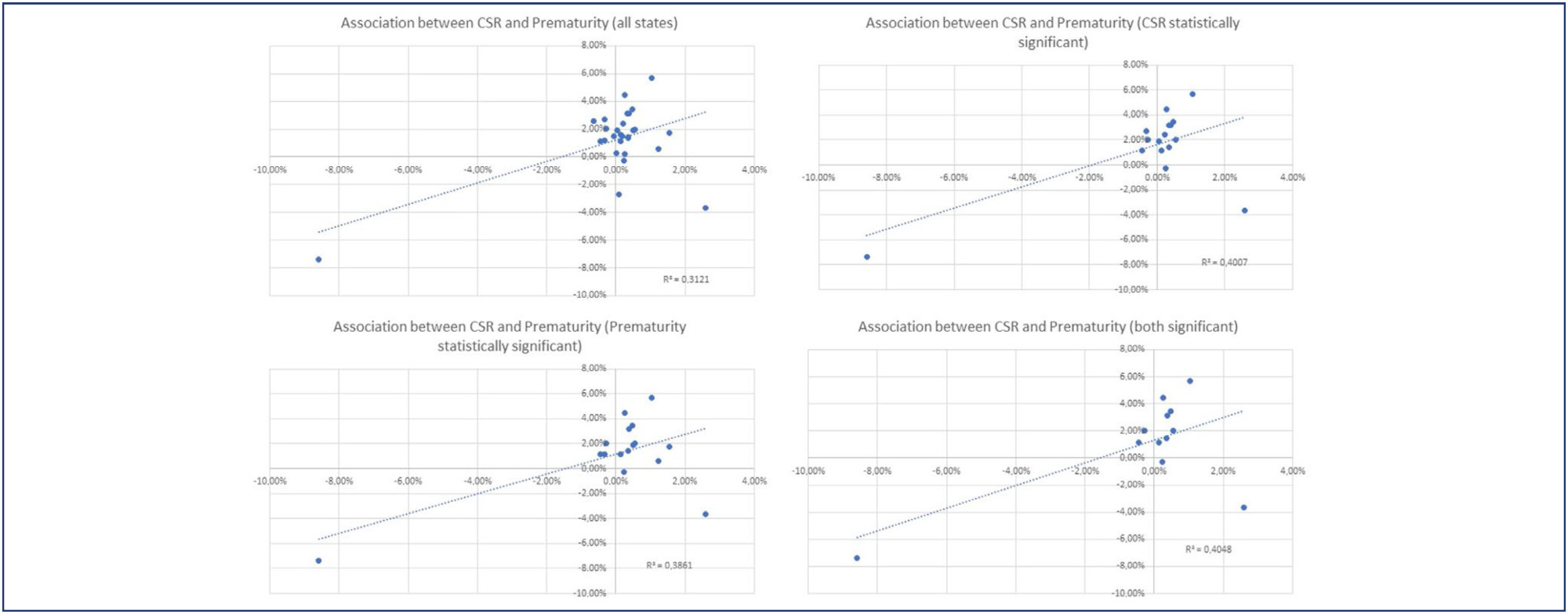
-
Original Article03-18-2025
Accurate evaluation of mode of delivery and labor progression with angle of progression: a prospective cross-sectional
Revista Brasileira de Ginecologia e Obstetrícia. 2025;47:e-rbgo5
Abstract
Original ArticleAccurate evaluation of mode of delivery and labor progression with angle of progression: a prospective cross-sectional
Revista Brasileira de Ginecologia e Obstetrícia. 2025;47:e-rbgo5
Views156See moreAbstract
Objective:
To determine the validity of the angle of progression (AoP) in predicting delivery mode among women in the second stage of labor.
Designs:
This prospective cohort study was conducted at the Obstetrics and Gynecology unit (OBGYN) of two hospitals in Vietnam. Transperineal ultrasound was performed for each woman to measure the progression angle in the second phase of labor.
Participants:
A total of 725 women with singleton pregnancies with cephalic presentation at term
Methods:
Transperineal ultrasound was used to measure the angle of progression in the second labor phase and to identify the delivery method.
Results:
The rate of vaginal birth in women with an AoP ≥ 120° on transperineal ultrasound was 70.2%. The optimal cutoff point of AOP ≥122° with sensitivity and specificity for vaginal birth were 87.8% and 80.7%, respectively the area under the ROC curve of 0.887 (p<0.0001). The study's sample size was restricted owing to deficiencies in resources and time.
Conclusion:
The likelihood of achieving spontaneous vaginal delivery can be predicted by the angle of progression measured with transperineal intrapartum ultrasonography during the second stage of labor in women.


This is an Open Access article distributed under the terms of the Creative Commons Attribution License, which permits unrestricted use, distribution, and reproduction in any medium, provided the original work is properly cited. 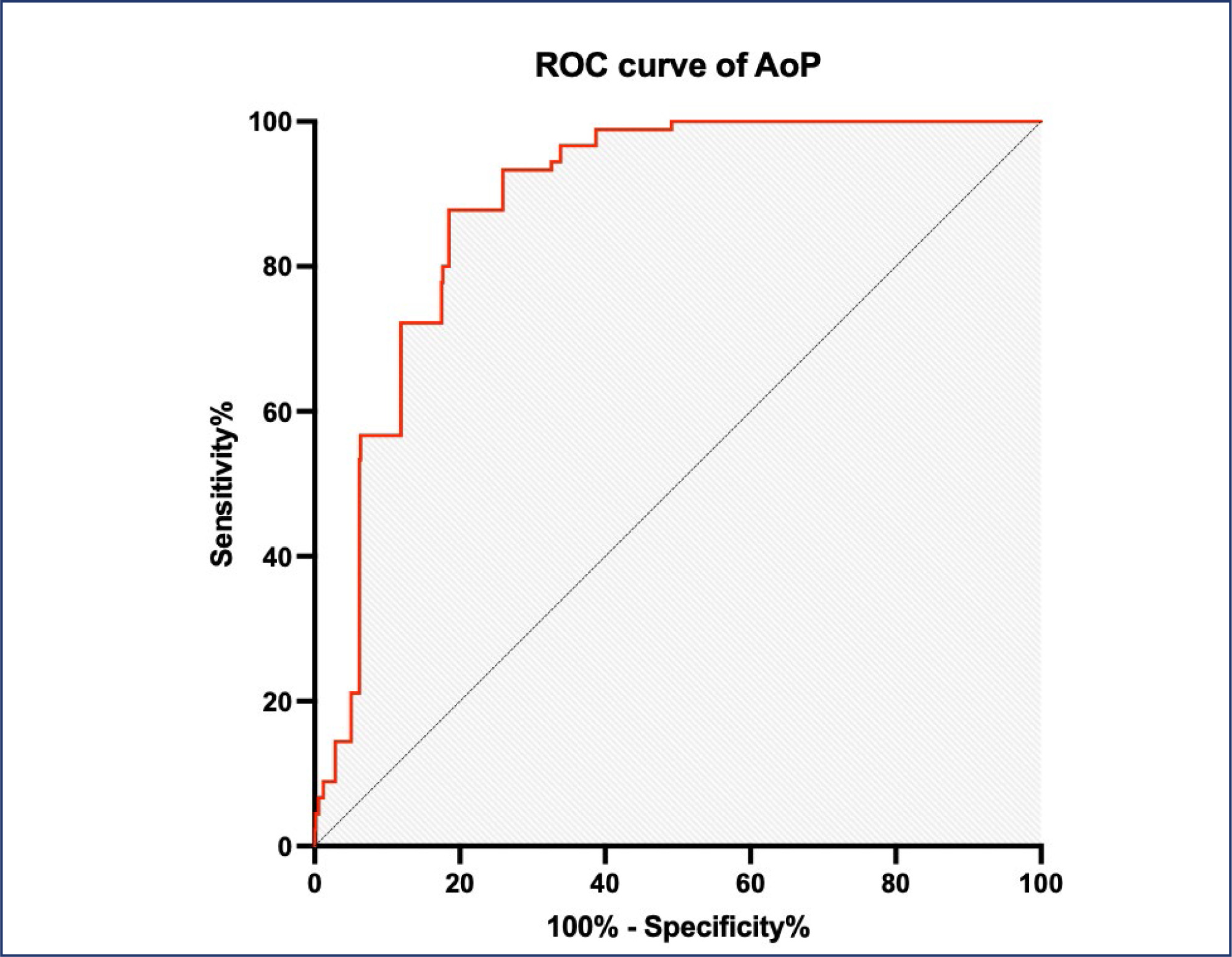
-
Original Article03-18-2025
Gastrin-releasing peptide receptor: a promising new biomarker to identify cervical precursor lesions and cancer
- Martina Lichtenfels
 ,
, - Rafaella Almeida Lima Nunes
 ,
, - Rossana Veronica Mendoza López
 ,
, - Camila Alves da Silva
 ,
, - Luiz Carlos Zeferino
 , [ … ],
, [ … ], - Lara Termini

Views137

This is an Open Access article distributed under the terms of the Creative Commons Attribution License, which permits unrestricted use, distribution, and reproduction in any medium, provided the original work is properly cited. Abstract
Original ArticleGastrin-releasing peptide receptor: a promising new biomarker to identify cervical precursor lesions and cancer
Revista Brasileira de Ginecologia e Obstetrícia. 2025;47:e-rbgo4
- Martina Lichtenfels
 ,
, - Rafaella Almeida Lima Nunes
 ,
, - Rossana Veronica Mendoza López
 ,
, - Camila Alves da Silva
 ,
, - Luiz Carlos Zeferino
 ,
, - Vanesca de Souza Lino
 ,
, - Adhemar Longatto-Filho
 ,
, - Louise De Brot
 ,
, - Silvia Helena Rabelo-Santos
 ,
, - Daniela Baumann Cornelio
 ,
, - Enrique Boccardo
 ,
, - Caroline Brunetto de Farias
 ,
, - Lara Termini

Views137Abstract
Objective:
This study aimed to verify the relation between gastrin-releasing peptide receptor (GRPR), oncogenic Human Papillomavirus (HPV) and cervical lesions severity.
Methods:
GRPR mRNA levels were evaluated in cervical cancer-derived cell lines and in primary keratinocytes expressing HPV16 oncogenes by RT-PCR. GRPR protein expression was assessed by immunohistochemistry in organotypic cell cultures derived from keratinocytes transduced with HPV16 oncogenes and in 208 cervical samples, including 59 non-neoplastic tissue, 28 cervical intraepithelial neoplasia grade 3 (CIN3), 44 squamous cell carcinomas (SCC) and 77 adenocarcinomas (ADC). Generic primers (GP5+/GP6+) were used to identify HPV infection in tissue samples. Experiments involving cell lines were analyzed through non-parametric tests (Kruskal Wallis), and Fisher’s Exact Test for human tissues samples. All statistical tests were considered significant at p <0.05. Immunohistochemical evaluation was conducted independently and blindly by two observers (AD- LO). Any discordant findings were resolved through discussion to reach a consensus score.
Results:
GRPR mRNA levels were not increased in cells expressing HPV16 or HPV18 oncogenes. However, at the protein level, GRPR was upregulated in organotypic cell cultures containing HPV oncogenes. Besides, it was identified an association between GRPR expression and cervical lesion severity (p < 0.0001). The detection rate of high-risk HPV DNA was directly correlated with cervical disease. Nonetheless, HPV infection was not directly associated with GRPR in cervical samples.
Conclusion:
GRPR expression is highly predictive of cervical lesion severity, irrespective of HPV infection and might contribute to improving patient’s therapeutic management as well as being used a marker of disease progression.
Key-words AdenocarcinomaCarcinoma, squamous cellGastrin-releasing peptide receptorHuman papillomavirusOncogenesPapillomavirus infectionsUterine cervical dysplasiaUterine cervical neoplasmsSee more

This is an Open Access article distributed under the terms of the Creative Commons Attribution License, which permits unrestricted use, distribution, and reproduction in any medium, provided the original work is properly cited. 
- Martina Lichtenfels
-
Review Article03-18-2025
Low-level laser therapy for nipple trauma and pain during breastfeeding: systematic review and meta-analysis
- Maria Victória Candida Gaitero
 ,
, - Ticiana Aparecida Alves de Mira
 ,
, - Edna Jéssica Lima Gondim
 ,
, - Simony Lira do Nascimento
 ,
, - Fernanda Garanhani Surita

Abstract
Review ArticleLow-level laser therapy for nipple trauma and pain during breastfeeding: systematic review and meta-analysis
Revista Brasileira de Ginecologia e Obstetrícia. 2025;47:e-rbgo3
- Maria Victória Candida Gaitero
 ,
, - Ticiana Aparecida Alves de Mira
 ,
, - Edna Jéssica Lima Gondim
 ,
, - Simony Lira do Nascimento
 ,
, - Fernanda Garanhani Surita

Views147Abstract
Objective:
This study aimed to investigate the effect of low-level laser therapy (LLLT) on nipple trauma and pain during breastfeeding through a systematic review with a meta-analysis of selected studies.
Source of the data:
A thorough search was conducted on March 22, 2022, using the databases PubMed, SciELO, LILACS, PEDro, CINAHL, EMBASE, ScienceDirect, Scopus, Google Scholar, MEDLINE, the Cochrane Library, Clinical Trials, Web of Science, TRIP, DARE, and ProQuest. The search terms included various combinations of low-level laser therapy, nipple pain, nipple trauma, and breastfeeding.
Studies selection:
Out of 107 articles identified, only three controlled and randomized clinical trials was included. The extracted data encompassed breast and trauma characteristics, treatment types, outcomes (pain and healing process), evaluation tools, LLLT usage, laser brand, and parameters.
Data collection:
Data extraction was performed using RAYYAN for systematic reviews. The risk of bias in the studies was evaluated.
Data synthesis:
Pain was measured using the visual analog scale (VAS). The included studies did not use validated tools for assessing physical conditions. All studies employed LLLT with a 660-nm wavelength, though there were variations in equipment power, energy dose, and application methods. The meta-analysis revealed an average difference of −0.60 points (95% CI: −1.52 to 0.31) in the VAS pain scores between the LLLT and control groups. No heterogeneity was observed among the studies (I2=0%), indicating no significant difference in pain relief between LLLT (red light) and control groups.
Conclusion:
LLLT may offer a promising option for managing breastfeeding-related complications, though further research is required.
Key-words Breast feedingLaser therapyLow level light therapyLow-level laserNipple painNipple traumaNipplesSee more

This is an Open Access article distributed under the terms of the Creative Commons Attribution License, which permits unrestricted use, distribution, and reproduction in any medium, provided the original work is properly cited. 
- Maria Victória Candida Gaitero
-
Review Article03-18-2025
Clinical repercussions of statin use during pregnancy: a review of the literature
- Joan Lins Serafim
 ,
, - Pedro Lucas Santos de Menezes Teles
 ,
, - Amanda Katharinne Souza Lima
 ,
, - Jéssica dos Santos Coelho
 ,
, - Paloma Luna Maranhão Conrado
 , [ … ],
, [ … ], - George Alessandro Maranhão Conrado

Abstract
Review ArticleClinical repercussions of statin use during pregnancy: a review of the literature
Revista Brasileira de Ginecologia e Obstetrícia. 2025;47:e-rbgo2
- Joan Lins Serafim
 ,
, - Pedro Lucas Santos de Menezes Teles
 ,
, - Amanda Katharinne Souza Lima
 ,
, - Jéssica dos Santos Coelho
 ,
, - Paloma Luna Maranhão Conrado
 ,
, - Valda Lúcia Moreira Luna
 ,
, - Pauliana Valéria Machado Galvão
 ,
, - George Alessandro Maranhão Conrado

Views126Abstract
Statins are the most widely used pharmacological class for treating hyperlipidemia, although they are contraindicated during pregnancy. This study aims to demonstrate the clinical effects of statins in pregnant women through an interactive review. Fifteen original articles were selected, in English or Portuguese, within of five years. Statins have not been associated with the development of fetal malformations and their use may be useful in preventing unfavorable cardiovascular outcomes, with the potential to reduce oxidative stress and angiogenic dysfunction. However, the use of statins to prevent pre-eclampsia in humans has not been properly clarified and further studies are needed. Pravastatin is considered safer than statins for use during pregnancy.
Key-words Antihypertensive agentsHydroxymethylglutaryl-CoA reductase inhibitorsPravastatinPre-eclampsiaPregnancyPregnant womanSee more

This is an Open Access article distributed under the terms of the Creative Commons Attribution License, which permits unrestricted use, distribution, and reproduction in any medium, provided the original work is properly cited. 
- Joan Lins Serafim
Search
Search in:
Tag Cloud
Pregnancy (252)Breast neoplasms (104)Pregnancy complications (104)Risk factors (103)Menopause (88)Ultrasonography (83)Cesarean section (78)Prenatal care (71)Endometriosis (70)Obesity (61)Infertility (57)Quality of life (55)prenatal diagnosis (51)Women's health (48)Postpartum period (46)Maternal mortality (45)Pregnant women (45)Breast (44)Prevalence (43)Uterine cervical neoplasms (43)

